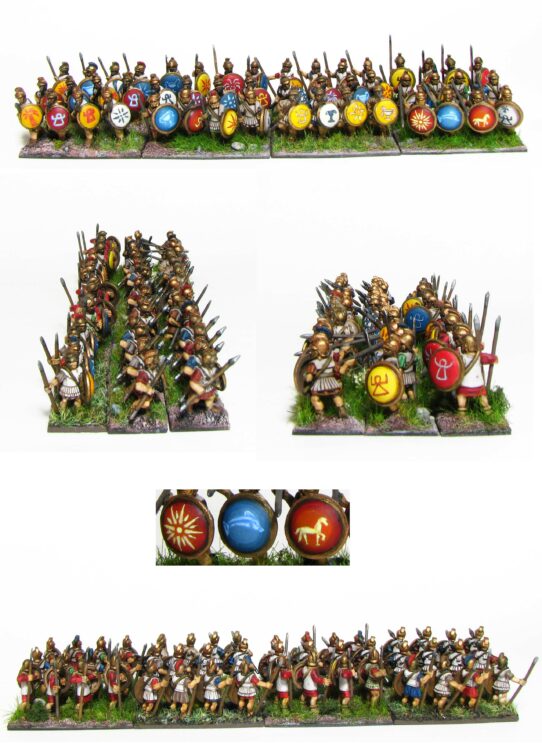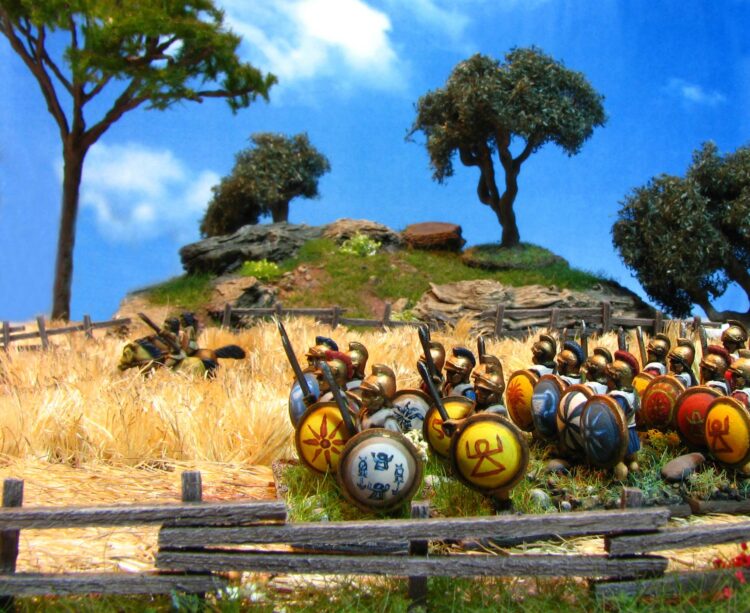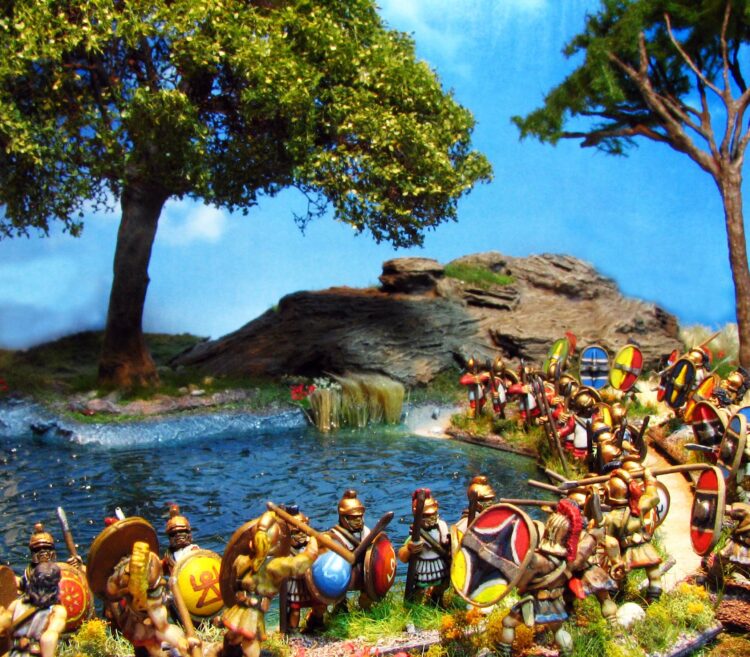Liby-Phoenician Spearmen – The backbone of the Carthaginian army
Having only a small citizen-body the Carthaginians relied heavily on foreign soldiers and mercenaries. The backbone of any Carthaginian army and the most reliable troops were the Liby-Phoenician spearmen. The Libyans were not merely mercenaries but could be provided by allied city states or might have been conscripted from a peasant base.
Before Hannibal’s Italian campaign they were presumably armed with long spears, round or oval shields. They wore bronze helmets of the montefortino type as well as linen cuirasses as protective armour. Quesada (2011) suggests that the thureos (a large oval shield) was introduced by the Carthaginians to Iberia. If you want to go down a rabbit hole, read my post on Iberian Scutati for more on this. If this is correct, it is possible that the Libyans used the thureos before the march over the Alps. However, it is equally possible, that Liby-Phoenician spearmen still relied on the aspis, with the thureos used by lighter troops.

Polybios reports that at the battle of Cannae in 216 BCE
the armour of the Libyans was Roman, for Hannibal had armed them with a selection of the spoils taken in previous battles. The shield of the Iberians and Celts was about the same size, but their swords were quite different. For that of the Roman can thrust with as deadly effects as it can cut, while the Gallic sword can only cut, and that requires some room
Plb. 3.114
This would suggest a gradual change to a more roman appearance, that could have started as early as the aftermath of the battle of the Ticinus or maybe the battle of the Trebia. The armour changed from linen cuirasses to mail or pectorals. The wording could imply that the spearmen used Roman style swords and shields. However, the spearmen might have kept their spears or used both weapons. If they still used the aspis, but realised that a thureos type shield is more effective to fend off the pilum, a gradual adoption of the scutum is likely.

The Miniatures: Sculpting and Painting
The Liby-Phoenician spearmen are a mix of Xyston, Corvus Belli and Old Glory miniatures. Xyston and Corvus Belli convince in every aspect, however, the Old Glory can not stand up to the high quality of the other two ranges. Mixed up they work well enough, but I will replace the Old Glory miniatures with some nicer sculpts.
The sculpting of the Xyston and Corvus Belli figures is very good and one does get a nice selection of poses and head varieties. The Xyston spearmen are bit more static, but rank up more easily. The sculpting of the Old Glory spearmen is rather rough in places (especially the legs) and some casting artefacts such as small holes can be found. Xyston has almost no flash, while Corvus Belli and Old Glory have moderate flash. Not too bad, but preparation of the last two will take you more time. Mold lines are not too bad with any of the three and you won’t get awkward lines across the face.

Time to paint the Libyans
I went for a colour scheme that reflects the fact that all Liby-Phoenician spearmen had to equip themselves. This implies that no uniformity existed and one is relatively free in terms of colours and shield designs.
I avoided purple for the common soldier, as this colour would have been expensive and reserved for the higher ranks. Red dye, however, was one of the goods Iberia was well known for, and with Carthage having a foothold in southern Iberia easy access to red dyes is likely. Green and blue I used sparingly. They can be achieved using natural dyes such as woad (Isatis tinctoria) for blue or a variety of herbs for a dark, pale green.
Trade and cultural exchange with Celtic tribes was common in northern Iberia, which would also account for access to locally used dyes such as woad. Browns and yellows are easy to achieve using herbs or natural earth pigments such as ochre. Especially for shields earth pigments might be an easy to procure and affordable way to adorn them. Untreated linen or wool finally adds an off-white or beige tone to the mix.
Shield designs
For the designs I used Greek, Phoenician and Carthaginian symbols: Palm trees, depictions of Tanit, animals and geometrical patterns. I started with the Old Glory miniatures to practice my free-hand abilities, followed by the Corvus Belli and Xyston shields. One can clearly see a difference in quality. The same goes for the rest of the paintjob. When I replace the Old Glory miniatures in some point. I’ll put some more time in the new ones to match the Corvus Belli and Xyston miniatures.
I will also paint up a full skirmish compliment of Hannibal’s veterans in 28mm with Roman equipment for his exploits in mainland Italy.
I like the mix of manufacturers and poses. Adds dynamism to the mass effect. Of course, OG are not going to be of the same qualify as Xyston and CB, but I think they add to the effect of the whole 🙂 Great job
Thank you and sorry for the late reply. it is true OG are pretty basic sculpts, but in combination with other manufacturers it really works quite well.
Your handwork on the shield design are brilliant. All of it a brushwork, I presume (too realisticly lively to be transfers)? Wondering if you ever thought to publish some designs as drawings to take inspiration from (or to copy by those of us that lack the imagination 😉 )
Seriously though, good samples of Gallic, North African and Iberian designs are hard to get by, especially if not familiar with the subjects.
Of course had occurred one if anyone would make tiny transfers for 6mm Greeks – other than the starburst.
Hi, yes all of them are freehands. The close-ups are obviously the best of the lot, after some more crude, earlier attempts.
Maybe someday I make a little painting guide in booklet form, just for fun ;).
There are some good samples out there if you look at the websites of shield transfer companies, such as Veni, Vidi, Vici or Schieldschmie.de. They even make custom designs. They might make tiny transfers for you, but in 6mm might be almost easier to paint them, instead of fiddling around with transfers ;).
Red dye nerd here – love the reference you made to the trade/realism of colours in this post ^_^
The pictures, especially with your terrain, are awesome! I love the glitter of the light on the water…and the adorably individual shields 🙂
Thank you. The water effect worked out well, but it is really the sun that is making it look so convincing.
Glad someone else is interested in ancient dyes. Hlaf the fun is historical research if it comes down to painting up some acient people.
Love the pic with the water feature in the background, nice work.
Thank you very much. Reminds me to make a tutorial on water features in some point.
The shields are really nice and the photography is exceptional. The compositions are so nice.
Thank you very much. I am glad the composition works. I am always a bit limited by the size of the background.
My favourite designs are obviously the three I singled out. I also have some dedicated Veteran Spearmen models with oval shields. Should be interesting to transfer some of the designs to their shields.
Thank you! Much appreciated. The compositions are really fun to come up with. I need to think how to present the Iberians best.
These guys look great! You really maximized the chance to be creative with the shields, and the designs you came up with feel like they were created by an ancient people with strong beliefs in an animistic/spiritual/magical world. Awesome scenery, as well.
Thank you. Glad you like them and the shield designs. I think the soldiers of that time might have believed in the protective power of the designs on their shields. Be it the protection of their goddess or maybe the symbol of their home town or an entirely personal symbol. I could also see that they filled dead time while on campaign with painting and refurbishing their shields.
Well, the effect is fantastic. Really makes you wonder “what’s this guy’s story?” Which is pretty rare in massed miniature armies!